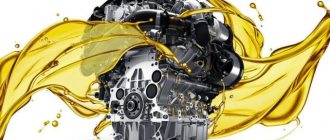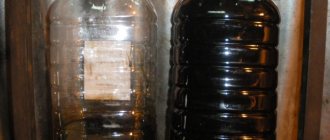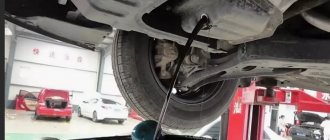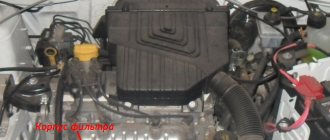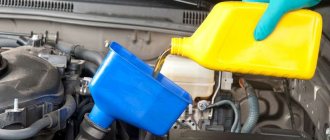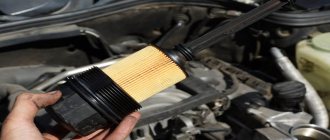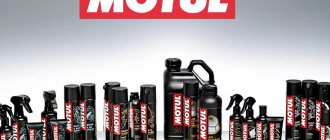The working fluid in the engine lubrication system is engine oil. In different units, the volume of lubricant poured differs, which depends on the working volume of the internal combustion engine, its physical dimensions and a number of other features.
To control the lubricant level, most engines use a mechanical dipstick, but some power plants do not have one. In this case, a separate electronic indicator is implemented on the dashboard. There are also combined solutions.
As a rule, during operation, a decrease in the lubricant level may occur for various reasons. Since it is impossible to continue operating the engine with a low level of lubricant, in this case you need to know how much oil to add to the engine, as well as how to do this without harm to the internal combustion engine.
In this article, we intend to talk about when to add oil to the engine, how to do it correctly, in which cases you can add another oil to the engine without risk, and also under what conditions this can cause possible harm to the unit or is strictly prohibited.
Step-by-step instruction
- Determine what oil can be added to the engine. In the car's passport, the manufacturer gives recommendations on the brand and viscosity of materials.
- Turn off the engine and leave it for several hours. During this time, both the engine itself and the oil will cool down to ambient temperature. Liquid from the walls will drain into the pan.
- Open the oil filler neck located at the top of the cylinder block. It is easy to find under the hood by the characteristic pictogram - an oil can with a drop.
- Insert a funnel into the neck. If the device is not in the trunk, you can make it yourself. To do this, cut off the top of the plastic bottle and insert it upside down into the container.
- Add oil to the optimal level. Check the amount of fluid with a dipstick.
- Close the neck with a lid and wipe all parts with a rag.
Consequences of excess and deficiency
The rule states that the amount of oil fluid when the engine is warm should be at the middle level of the dipstick, between the min and max marks. How to measure it correctly? You need to warm up the engine to operating temperature by taking it for a short drive. Then stop the car on level ground, turn off the engine and wait 15–20 minutes until the oil mixture drains into the crankcase. After this, open the hood, remove the dipstick and wipe it dry with a rag. Then it is inserted again, and the level is measured, which is clearly visible along the edge of the oil strip. If this edge is located between the min and max marks, you don’t have to worry as you continue to drive the car. But if it goes beyond this zone, there can be serious trouble.
Overflow
Many novice car enthusiasts think that the more lubrication in the engine, the better it works. Some people try to fill the liquid exactly to the max mark and above, believing that “you can’t spoil the porridge with oil.” Is it possible to add oil to this level? The answer will be unequivocal - no. The first symptom is a deterioration in the crankability of the power unit. The oil mixture has a certain viscosity, and its excess quantity further increases the resistance to any movement. Therefore, increased fuel consumption occurs. This is far from the most unpleasant phenomenon. Other consequences are beginning to take effect.
The expansion of oil fluid at high temperatures creates pressure on gaskets, seals, and other sealing parts above normal. Gradually they begin to be squeezed out, resulting in lubricant leakage. This especially applies to crankshaft oil seals, the bearings of which are supplied with lubricant under pressure. As a result, the entire engine compartment becomes dirty, and the seals will have to be replaced. Other symptoms:
- Difficulty starting the engine in frosty weather;
- the formation of an excessive amount of carbon deposits, the appearance of coke inside the cylinder-piston group, the “bedding” of the rings;
- foaming of the composition, which will result in oil starvation of engine parts.
As you can see, the consequences of overflow can be catastrophic.
Underfilling
The lack of a sufficient amount of lubricant also has a detrimental effect on the power unit. Oil starvation of parts occurs. The lubricant either does not arrive at all, then they work “dry,” or it arrives in completely insufficient quantities, unable to form a high-quality oil film between the contacting surfaces.
Another consequence is the formation of air pockets inside the lubrication system, which will circulate through the channels. The crankshaft will begin to rotate without lubrication, and chips will form, which will certainly fall into the oil. The crankshaft counterweights will not be able to scoop and spray lubricant onto the cylinder walls, so the pistons will eventually seize. That is why it is necessary to regularly check the lubricant level and then top it up if necessary.
Cold topping
Most often, oil is added to a cooled engine.
This makes it easier to track the level and avoid underfilling. The rule is applicable only for warm seasons, when the air temperature is above zero degrees. In winter, the engine is preheated. Then the car is turned off and left for a few minutes. The engine cools down, but the lubricant remains in a viscous-flowing state, which allows you to more accurately assess its level. Oil is added to the engine after measuring. If the car is not warmed up, the old material in the lubrication system will remain too thick. It will be difficult to determine its quantity with a dipstick.
How to add oil when it gets low
The need for topping up is determined in the following ways:
Consumption standards for fuels and lubricants for mechanized work performed in forestry
- When checking the level with a dipstick, a position below the MIN mark is observed. You need to estimate the amount of fresh lubricant that will be needed to bring the readings to normal;
- when an icon appears on the information display indicating a decrease in oil pressure in the system. The oiler lights up red on the dashboard information display. In older car models, the pressure arrow shifts upward very reluctantly as the speed increases.
The approximate amount of lubricant that needs to be poured into the engine can be calculated using the data in the attached table. For each mm of level on the dipstick, you need to add the suggested measure. You should be guided by the readings that can be obtained from the measuring ruler of the canister. Modern containers have a transparent layer and a ruler. They will make the work of the car enthusiast easier.
- You need to take any rag or napkin. Clean the filler plug. A significant amount of contaminants can accumulate there.
- It is advisable to wear cotton work gloves (putting several pairs in the trunk will not hurt anyone).
- The plug opens. Its opening does not pose any danger. The pressure in the crankcase and the environment is balanced through the breather, which is discharged into the air filter.
- A funnel is required. Then oil drops will not end up on the surface of the engine. It can be quickly cut from a plastic bottle. The neck diameter of most engines is slightly smaller than 21 mm (the diameter of the threaded part of most plastic bottles).
- The approximate amount is poured into the motor.
- The level is checked 3...5 minutes after filling. All poured oil will flow down the walls into the oil pan.
Table 1: Amount of engine oil to fill into the crankcase
| Engine displacement, cm³ | It is necessary to add to compensate for 1 mm on the dipstick, ml | Engine displacement, cm³ | It is necessary to add to compensate for 1 mm on the dipstick, ml |
| 500 | 4,6…5,1 | 1800 | 40,8…41,6 |
| 600 | 6,6…7,0 | 1900 | 44,6…45,0 |
| 700 | 8,3…9,0 | 2000 | 48,8…50,0 |
| 800 | 10,3…10,9 | 2100 | 53,1…54,0 |
| 900 | 12,5…13,3 | 2200 | 57,4…58,2 |
| 1000 | 15,0…15,8 | 2300 | 61,8…62,6 |
| 1100 | 17,8…18,6 | 2400 | 66,4…67,1 |
| 1200 | 20,1…21,5 | 2500 | 71,1…71,9 |
| 1300 | 23,4…24,1 | 2600 | 75,9…77,1 |
| 1400 | 27,4…28,2 | 2700 | 80,8…82,2 |
| 1500 | 29,7…30,5 | 2800 | 85,9…87,1 |
| 1600 | 33,3…34,4 | 2900 | 91,1…93,3 |
| 1700 | 37,0…38,0 | 3000 | 96,4…98,3 |
Hot topping
There are situations when you need to add oil while on the road. For example, while driving, a signal from the on-board computer is received, or the oil pressure drop indicator lights up. The driver stops and adds oil to the hot engine - there is no time to cool it. The consequences of such an act depend on the conditions.
Topping up in summer
The temperature of the oil in the engine and in the canister will differ slightly. With such topping up, there is a risk of incorrectly assessing the level, but it is not critical. You can safely add oil to the engine and drive on.
Topping up in winter
The oil is in a canister in the trunk. Its temperature is below zero. Cold oil is added to the engine at a temperature of +90 °C. If the volume of added liquid does not exceed 100 ml, then there will be no unpleasant consequences. If you need more oil, you should cool the engine. The temperature difference between liquids can cause cracking of the block, head, and other engine parts. Cooling will also reduce the risk of underfilling or overfilling.
How often to add oil to the engine
As already mentioned, oil is added to the engine in different cases. The lubricant level can decrease either due to natural reasons or drop as a result of engine breakdowns, after incorrect selection and mismatch of the type of product used, changes in the properties of the lubricant, etc.
To understand whether it is necessary to add oil to the engine, you need to check its level by placing the car on a level surface. It is advisable to check the level “cold”, after several hours of inactivity, that is, when the lubricant has completely drained into the pan. For a quick check, it will be enough to wait 5-15 minutes, but such an analysis may be more approximate than accurate.
Taking into account the characteristics of a particular internal combustion engine, you can understand whether topping up is needed and how often it is necessary. In some cases, it is necessary to add lubricant, for example, every thousand kilometers, which is typical for faulty units with increased oil consumption as a result of wear of the CPG, leaks of oil seals, gaskets, and seals.
In other internal combustion engines, the level remains stable, that is, lubricant is not added from replacement to replacement. Also, the level can be stable in the city and in medium load modes, but after driving on the highway at high speeds, a decrease is observed. In such a situation, it should be remembered that lubricant under high load conditions is wasted, as is often stated by the engine manufacturers themselves.
Moreover, the manual may separately indicate that oil consumption is not only acceptable, but also within what limits it is normal for a particular engine. Based on all that has been said, you can understand what frequency of topping is suitable in a given case.
What to do if you don’t have the right oil at hand
There are situations when there is no supply of lubricant, and you need to top it up urgently. Drivers use any available oil: a product of a different brand, of different viscosity and even purpose. In a critical situation, this is allowed, for example, to travel to a car service center or to the nearest garage for service. It is advisable to maintain the type of base: add mineral oil to mineral oil and synthetic to synthetic. There will be minimal risk when topping up with material from the same manufacturer. When driving with this oil, try not to overload the engine. As soon as possible, change the fluid along with the filter.
In other situations, you cannot mix different materials. Active additives can interact chemically. Sediment and carbon deposits form in the engine, and oxidative processes accelerate. You will have to completely drain the fluid, flush the engine and fill in new oil.
Typical rookie mistake
Often inexperienced drivers fill in as much engine oil as possible, believing that this will be better. Overfilling in excess of the norm is not only undesirable, it can harm the car engine. The danger lies in the following aspects:
- oil has a certain viscosity, and their quantitative excess impairs engine crankability. This results in maximum fuel consumption;
- When heated, liquids expand and the pressure they exert increases. Excess oil mixture leads to squeezing out gaskets and seals;
- cold starting of the engine is difficult;
- excess carbon deposits and “bedding” of rings;
- excessive foam formation.
Not adding enough oil also has negative consequences:
- friction increases, chips form on the crankshaft;
- Over time, the cylinder pistons become jammed.
How to determine the oil level
Some car owners and craftsmen believe that this should be done “cold”, others – “hot”. The former argue their position by the fact that the lubricant will have time to drain into the sump while the engine is cooling, which will make the measurement more objective. The latter claim that when cooled, it contracts, so the level (especially in winter) turns out to be underestimated. That is why it is better to determine the level in two ways. In the summer, one method is sufficient, since the differences between “cold” and “hot” are insignificant.
Measurement algorithm:
- The machine is located on a level area.
- The engine needs to be turned off.
- After a maximum of a quarter of an hour, the lubricant will drain into the crankcase.
- The driver removes the dipstick and wipes it with a clean rag.
- The dipstick is installed back.
- After 3-5 minutes, the probe is removed again (you must try not to touch the walls of the hole with it, otherwise the measurement result will be incorrect).
What is taken into account when selecting motor oil
When choosing a lubricant for an engine, you should not rely only on your own preferences or be guided only by a low price. To select a motor oil with optimal characteristics, a number of factors should be taken into account.
- Manufacturer's recommendations
. In the instructions for each car model, the manufacturer always indicates the optimal viscosity of engine oil for winter and summer. The lubricant should be selected based on this characteristic. - Engine condition
. If the car is old and only mineral oil has been poured into its engine for many years, you should not replace it with synthetic oil. Synthetics are recommended for use on new cars. - Type of equipment.
When selecting a lubricant, the type of car must be taken into account. For example, for passenger cars, SINTEC offers a unique PLATINUM line with a package of multifunctional imported additives, for commercial vehicles - the TRUCK, DIESEL and other series, designed for vehicle operation in difficult conditions.
Features of adding oil in winter
In winter, the risk of cracks appearing on a hot engine when pouring cold lubricant increases. Therefore, topping up must be done in a warm room, in a garage, but not outside at a temperature below 10 degrees minus.
In general, experienced mechanics advise changing the engine lubricant at service centers. Since in these hangars the temperature is always maintained appropriately and no distortions in the engine due to temperature differences will occur.
Topping up rules
First, you need to find out what brand of oil was poured into the engine. When selling a car, the former owner usually reports what type of oil he used. All that remains is to purchase an analogue with the desired viscosity coefficient.
Topping up is carried out only when the oil level “on the dipstick” does not reach about. When performing such a check, remember that if the engine is hot, the oil has not completely drained into the crankcase. When the engine cools down, the lubricant level will be higher. Therefore, to obtain accurate data, you must wait until the unit cools down. 15-20 minutes is enough.
In winter, to check the level, experts advise slightly warming up the internal combustion engine. The fact is that in cold weather the oil begins to freeze, and after heating the volume will increase slightly.
What is the importance of motor oil for an engine?
The lubricant has main tasks, without which the motor simply cannot get into working condition. But it is also important to understand that the oil itself, when the engine is running in a charged state, takes on a heavy load in the form of temperature changes. The lubricant must withstand stress and elevated temperatures, which sometimes reach several hundred degrees. At the same time, the oil should not lose its lubricating properties. What lubrication does to the engine:
- When the motor parts come into contact, the coefficient of friction decreases and scuffing is prevented. This is exactly the job assigned to friction modifiers found in motor oil.
- The service life of the motor is significantly extended due to anti-wear additives.
- In the piston group, the gaps between the rings and cylinders are sealed, thus the compression increases, and the hot gases that form in the combustion chamber do not enter the piston system.
- Thanks to the basic composition, regardless of its origin (synthetic substances or mineral), heat is removed from all rubbing surfaces.
- Due to detergent additives, dispersants and detergents, the cleanliness of the internal combustion engine is ensured, carbon deposits, slagging and varnish deposits are removed.
- The antioxidant inhibitors found in the lubricating fluid allow the lubricant to work longer without losing its main functions.
- Corrosion of metal parts does not occur due to anti-corrosion additives added to the oil. They not only prevent surface corrosion, but also protect them from oxidizing processes.
- The process of foam formation in the liquid is also stopped thanks to anti-foam additives; they do not allow oil deficiency to occur between engine parts.
The power unit remains in normal operating condition, since the oil is capable of performing several important functions at once. The need to add lubricant is as important for a car as checking the brake fluid level or whether there is the right amount of fuel in the fuel tank. Remember that the lubricant level should never be below the minimum level, otherwise you may have major troubles associated with engine repairs.
